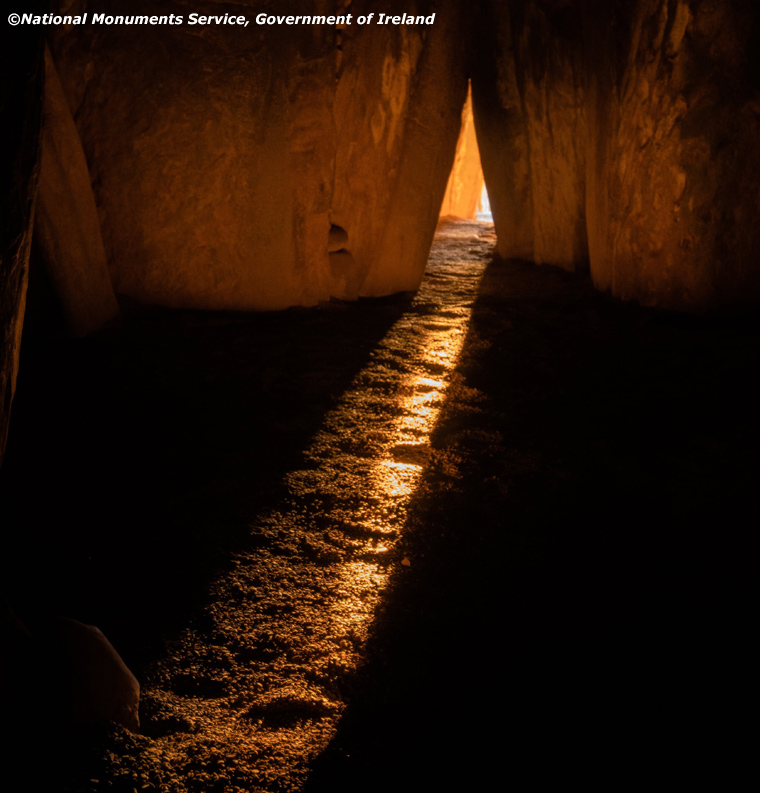Solstice watchers fail to see the light at Newgrange
An article by Eileen Battersby printed in the Irish Times.
Newgrange - 21st December 2005
They came from Australia and South Africa; from Yorkshire and Cardiff; from parts of Dublin as well as from just down the road.An impressively good-natured group gathered in Newgrange, Co Meath, yesterday morning to experience what has become for some moderns, the devout and the curious, an annual tradition - the winter sun entering the roof box at the famous Neolithic monument to slowly, dramatically make its way up the passage to fill the ancient chamber.
It does happen. Science and belief, the importance the Stone Age farmers who built Newgrange placed on the value of the sun's favour, and the sun itself all contribute to the wonder that is the winter solstice. That said, no amount of prayer or inspired engineering can make the sun shine. And yesterday - it didn't.
Seasoned solstice watchers, professional archaeologists among them, first-time visitors, many with information sheets printed off the internet, all stood in the grey early morning to take part in the vigil. While sunrise within the chamber is reserved for invited VIPs and ticket-holders, once they leave everyone present takes their turn to enter the monument.
Shortly after 5am, rain fell in the Boyne Valley. The sickly moon flickered in and out of the cloud cover, and finally spluttered out. The morning sky was black, and the air was merely damp, not cold. It was not promising. The standing stones which appear to guard the monument became more sharply defined with every passing minute. Everyone had an opinion, and most agreed that a minor class of miracle was needed to witness the central miracle.
The atmosphere remained jovial. After all, at least the year's longest night was over. Cars lined both sides of the lane. Three men walked as one, the tallest ashen-faced from an office party. The number of babies in attendance was noticeably higher than usual. One very short woman carrying a large baby, began describing to the infant what would happen - if the sun came out. The baby slept on. The woman looked tired. "Was it better yesterday?" she asked.
Watches were checked. Eyes raked the sky. You could feel the communal concentration. A television crew looked sympathetically at its journalist.
"Mam, where is the sun?" demanded a teenage girl wearing headgear approaching Arctic explorer quality teamed with a tiny white top. The heavens remained resolutely grey.
The arrival of Minister for Justice Michael McDowell seemed to settle the matter. "Look who it is," said a younger man to his girlfriend who appeared to be freezing, "it's bound to start raining." Not even the combined good will of the onlookers and of the ancients themselves could persuade the sun to brave the wrath of the Minister, who might just decide on impulse to issue some kind of ban or writ.
"Blame him," hissed two girls. As Mr McDowell began his journey up the passage, a voice broke the silence: "He'll be lucky to get out alive. The spirits will get him. It could be the first human sacrifice in 5,000 years." Sufficient tittering greeted this to encourage the same comedian to continue: "He's frightened the sun away." Even without the spectacular natural drama, solstice morning at Newgrange is symbolic.
"It didn't happen," said a girl. "Of course it did," countered her friend, "it just went on behind the clouds." She was right. Winter has begun its slow leave-taking, the light will return and the ritual of rebirth will follow.
Eileen Battersby - The Irish Times
Winter Solstice Dates
Solstice literally means 'Sun Stands Still', for a few days around the time of the winter solstice the sun appears to stand still in the sky in that its elevation at noon does not seem to change. Click here for more information.- 19th December 2023 Winter Solstice.
- 20th December 2022 Winter Solstice.
- 20th December 2020 Winter Solstice.
- 18th December 2016 Winter Solstice.
- 20th December 2015 Winter Solstice.
- 19th December 2014 Winter Solstice.
- 21st December 2013 Winter Solstice.
- 18th December 2011 Winter Solstice.
- 22nd December 2010 Winter Solstice.
- 19th December 2010 Winter Solstice.
- 22nd December 2009 Winter Solstice.
- 21st December 2009 Winter Solstice.
- 21st December 2008 Winter Solstice.
- 21st December 2007 Winter Solstice.
- 22nd December 2006 Winter Solstice.
- 21st December 2006 Winter Solstice.
- 21st December 2005 Winter Solstice.
- 20th December 2005 Winter Solstice.
- 21st December 2004 Winter Solstice.
- 19th December 2004 Winter Solstice.
- 21st December 2003 Winter Solstice.
- 22nd December 2002 Winter Solstice.
- 21st December 2001 Winter Solstice.
Boyne Valley Private Day Tour
 Immerse yourself in the rich heritage and culture of the Boyne Valley with our full-day private tours.
Visit Newgrange World Heritage site, explore the Hill of Slane, where Saint Patrick famously lit the Paschal fire.
Discover the Hill of Tara, the ancient seat of power for the High Kings of Ireland.
Book Now
Immerse yourself in the rich heritage and culture of the Boyne Valley with our full-day private tours.
Visit Newgrange World Heritage site, explore the Hill of Slane, where Saint Patrick famously lit the Paschal fire.
Discover the Hill of Tara, the ancient seat of power for the High Kings of Ireland.
Book Now
Home
| Newgrange
| Knowth
| Dowth
| Hill of Tara
| Fourknocks
| Loughcrew
| More Places
| Labyrinths
| Local Info
| Art Works
| Articles
| Images
| Books
| Links
| Boyne Valley Tours
| Contact
